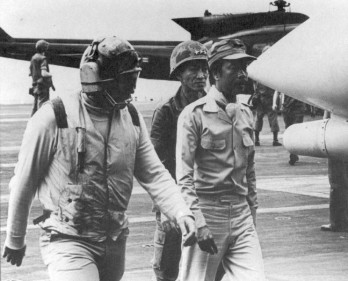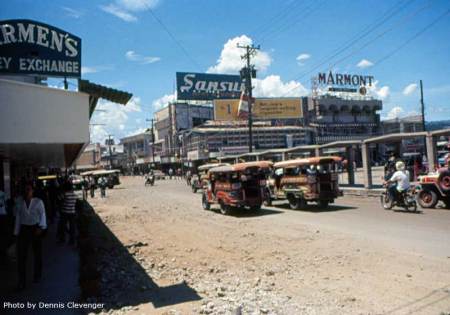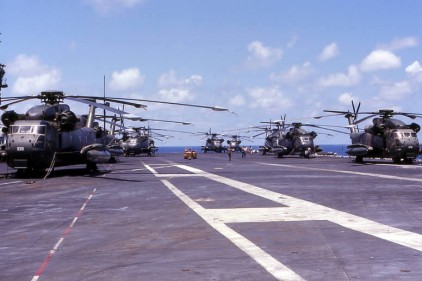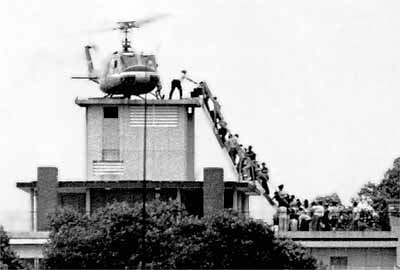Dave’s Frequent Wind

(Air Vice Marshall Ky arrives on USS Midway (CV-41) during the evacuation of Saigon. His lavender jumpsuit and white silk scarf are impeccable. Official US Navy photo.)
This is a recollection from a shipmate and Midway Sailor who was in the middle of the craziness that went with the end of the war in Vietnam. I am going to try to be comprehensive. My pal the Argonaut knows a woman who escaped from Vietnam that week with her parents- and I hope to get her side of the story. Dave’s words today stand exactly as he wrote them. We will circle back on Midway, and the role and function of the Mission Planning Spaces on the ancient mariner- but for now, come back to 1975 with Master Chief Dave.
Remember: I could be writing about politics, and then we would all be sick before lunch.
Let’s go back to the end of the American adventure in Viet Nam:
“The cruise started like any on Midway Magic. The routine was Christmas in-port Yokosuka then head south to warm water and sun. Once at sea and Carrier Air Wing 5 brought aboard from the air field at Atsugi we began to steam south, slowing doing doughnuts in the sea while the aircrews did refresher and carrier quals; touch-and-goes making noise to those of us working directly below the wire in CVIC.
News reports were the best source of intel as we steamed south. The North Vietnamese Army (NVA) was on the move in violation of the terms of the Paris Peace Accords, which prohibited the introduction of additional troops into the country. The Republic of Viet Nam’s Army (ARVN) was disintegrating, soldiers were leaving to find their families and to try and find a way out. The proud base at DaNang, once a major center of activity for U.S. Naval Forces-Vietnam and Marine Corps fell to the NVA. Overloaded South Vietnamese Navy and civilian junks moving refugees further south.
In addition to the situation in Viet Nam a parallel war was going on in Cambodia. Midway changed course and we headed to Okinawa where a Marine Expeditionary Unit (MEU) was flown aboard for a quick run south. Japanese news outlets overflew Midway in rented aircraft and reported that we were heading to South East Asia. As we approached the area of operation, the Marines flew off and Handjob- USS Hancock (CVA-19)- became a helicopter carrier.
Midway took a position off of Vietnam with orders to stand ready to supply air support in the event that the evacuation of Phnom Pen turned ugly, and the pragmatic Thais refused the U.S.A.F. use of its airfields to launch the evacuation.
Midway steamed off the coast while the evacuation went off without the need for air support. We turned east and headed for a liberty call in Subic Bay. As normal, the majority of the air wing flew off to Cubi Point to spend the ten-day in-port period. On the third morning at pierside, my Leading Chief Pete asked if I needed to do anything ashore.

(Looking out the Main Gate of NavSta Subic. The famous Marmont Hotel is to the right. Pre-paved Magsaysay Boulevard beckons. Photo Dennis Clevenger.)
I took it as an offer of a “rope-yarn day”—a day off to run errands, catch up on sleep etc. Instead, this was an “if you have laundry ashore, go get it and get back here we are going to sea.” Consequently, there was a mad dash to the front gates though the MPs and SPs were only letting those with letters stating they were on the search for shipmates on or at liberty were allowed out the gates.
We left Subic with a number of Sailors holed up in barrios around the countryside and as we went to sea the remainder of the air wing flew ashore leaving us with just a few F-4s to sit on the catapult for emergency combat air patrol. The air wing stayed behind in Cubi as the Midway steam towards Thailand to pick up a squadron of U.S.A.F CH-53 helos. Midway also became a helicopter carrier.

After the fly-on of the squadron off of Utapao, Thailand, the aircrews met in CVIC’s mission planning space to get briefed on life aboard Midway Magic. One of the zoomies had scoped out the weight room located near the foc’scle, though he announced the location pronouncing it is correctly spelled: “fore-castle.” Smirks emerged on the faces the squadron AIs and the Sailors listening to the brief in the back of the compartment.
We steamed around the South China Sea taking up station on what was called “Dixie Station” in contrast to the more common historical name for the northern op area for strikes against the North: Yankee Station. As planning continued, the NVA continued moving south with cities falling without much of a fight and refugees clogging the highways and anything that could float putting out to sea.
Soon, Navy ships began taking on passengers from the overcrowded boats and flights from Tan Son Nhut Air Base began Operation Baby Lift: moving orphans and Amer-asian children to safety.
In CVIC, we were helping the Air Force pilots prepare charts for the mission and maintain map boards showing the NVA advances. A message arrived announcing that UNODIR the airbase would be closed between 0000-0400 for runway maintenance.
A young AI went to the boss- the CAG AI, LCDR Jim- and asked him if he knew where UNODIR was located, next they were at my desk asking me to look it up I handed them a gazetteer and off they went back to Mission Planning to find the air base. About an hour later LCDR Jim went back and told them UNODIR was the acronym for “unless otherwise directed” and since the message was from Cubi it meant Cubi would be closed. We had a good laugh at the butter bars.
Planning went on. An issue with flying U.S.A.F. helos off of an aircraft carrier is that the Air Force usually operates with plenty of room and doesn’t go to the expense of installing foldable rotors on its birds. This meant that they would be used to fly in and out of Saigon and Navy birds would move the refugees to the smaller-deck ships.
On the Midway, pneumatic air tubes were used to send “bunnies” containing flash and immediate precedence messages from the comm center to other parts of the ship. The tube connecting Main Comm to CVIC passed thru one of the squadron skipper’s stateroom. So, every night as the bunny ran thru the tube the skipper was in his robe heading to CVIC to see if the order had been given to launch.
NVA units on the outskirts of the city launched an attack on Tan Son Nhut Air Base, hitting the Defense Attaché Compound and damaging the runway. The fixed wing rescue operation was over.
After sitting off the coast near Vung Tau and watching the fireworks exploding ashore, the order was finally given to execute the evacuation of Saigon by helo. The first thing was for Marines to land and supplement the Embassy MARDET Security Guards. Then the Air Force Jolly Greens started their flights, going feet wet over possibly hostile territory. It was unknown if the NVA had shoulder fired SAMS (surface to air missiles) and if so, would they fire on the rescue missions?
As the first helos approached, the cadre of ship’s company personnel were on the flight deck poised to receive the refugees. At the embassy compound in Saigon, weapons were taken from the refugees and thrown in the swimming pool, but upon arrival on the ship part of the processing was another search. Needless to say, a large number of weapons were confiscated.

(Iconic image of the Roof of the US Embassy, seen from the Caravel Hotel. Photo photo: Neal Ulevich/AP)
Along with the arrival of the Jollys an armada of RVN Air Force helos appeared: CH-47 Chinooks and UH-1 Hueys, mostly, along with the infamous Air America silver-and-blue UH-1s. Many of the South Vietnamese pilots panicked and ditched the planes in the sea near a Navy ship hoping to be picked up.
Several officers who had ground time in Viet Nam (including LCDR Jim) tried to sort out the military and civilian refugees to identify those that had knowledge of the whereabouts of other Americans. The squadrons AIs spent their time debriefing the aircrews regarding possible hostile forces, AAA guns or SAMs. And enlisted Intelligence Specialists tried to keep track of everything on the charts in mission planning. Today, CNN and the Internet broadcast what is happening in conflicts on the ground in real time. Then, we monitored the wire service teletypes to get the latest AP and UPI scoop from the ground.
The Miracle Plane came in during the afternoon. At first, it was thought that it might be a kamikaze aircraft heading out to attack the fleet. A few RVN AF fighters had attacked the Presidential Palace. The Miracle Plane turned out to be an O-1 Birddog FAC bird with a Vietnamese major, his wife and five kids. He circled Midway and one of flight deck crewmen notice he was throwing something out of the window. The miracle was that a paper page hit the windswept deck containing a scribbled note asking the deck to be cleared so he could land. It took seconds for skipper CAPT L.C. Chambers to order the ramp cleared and the crew pushed a couple of Hueys and a Chinook over the side. The O-1 made the approach and came to stop in a near perfect landing.
Sometime during the evacuation Vice Air Marshall and former Vice Pres. Ngueyn Ky landed in a nearly new Huey sporting I think a lavender flight suit with a sporty neck scarf. The refugees continued with a mix of Vietnamese, Americans and other nationals that had been able to secure a seat.
Reporters lined the passageway outside Main Comm trying to get a “class easy” message off the ship with the news of the evacuation. The backlog started on board as the Navy birds carried fewer passengers than the inbound Air Force Jollys. The hanger deck was used to hold them until they could fly off, and the forward mess deck was opened up to feed the refugees. Compartments vacated by the air wing who stayed behind in Cubi were opened for those that got to spend a night with us.
As night fell, the evacuation slowed and eventually stopped with the flight deck jammed with a wild assortment of Air Force, Air America and Vietnamese helos.
And of course, the lone O-1 Birddog. Eventually the Ambassador was ordered to leave and Marines were withdrawn. That was not it, though. As I recall, the last two casualties of the war were two Marines killed at the DAO compound. Their bodies were temporarily left behind, but then recovered.
The newswires signed off and the war was over. The last of the refugees were moved to the other ships and the task force and the Midway headed south to drop off the Air Force Jollys and head hopefully to grab some liberty!”
Copyright 2012 Master Chief Dave
Next: the trip to Thailand.
